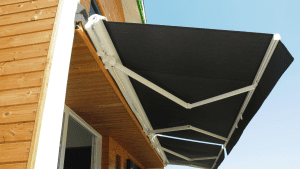In truth, awnings have become an increasingly prevalent feature among homes and commercial buildings, fusing comfort with modern practicality. Awnings serve as beautiful enhancers as well as practical shading, energy-saving, and weather-protecting devices. Whether having the purpose of beautifying a patio or contributing much to a more energy-efficient setting, this extensive awning guide will reveal everything you need to learn.
What Are Awnings?
These are secondary coverings attached to outside buildings and their adjacent parts, such as windows, doors, patios, and outdoor decks. These can be materials that serve as shade, heat minimizers, and all other forms of rain protection. They exist in any number of forms and types and serve a great many different jobs, both residential and commercial.
Key Benefits:
- Solution Shading: Defines outdoor and indoor areas from harsh sunlight.
- Energy Efficiency: Cuts costs in cooling indoors.
- Weather Protection: Shields from rains, UV rays, and wind.
- Aesthetic Appeal: Added an elegant touch to your property.
Types of Awnings
Selecting the correct awning depends on your specific needs. Here are the most common types:
- Retractable
This shading solution may be extended at will. They are especially suitable for patios and terraces, allowing the user to enjoy sun or shade as necessary.

- Stationary
These are fixed structures that provide permanent shading and weather protection. They are durable and great for long-term use over windows or doors.
- Freestanding
Perfect for open spaces, freestanding awnings can be placed independently in gardens, pool sides, or outdoor seating areas.
- Window
Designed specifically for windows, these awnings help reduce indoor heat while adding a decorative element.

- Motorized
These high-tech options provide convenience with remote control operations, making them perfect for modern homes.
Materials Used in Awnings
The strength, function, and appearance of an awning would all depend on the material chosen. Some of the materials are:
- Canvas: The most traditional and inexpensive, with several color and pattern choices.
- Acrylic: Mildew- and fade-resistant. Best suited for outdoor use.
- Metal: It provides serious weather protection but with a very sleek, modern look.
- Polyester: Lightweight and water repellent; good for those who do not mind strict budgets.
How to Choose the Right Awning
Choosing the correct awning involves considering several factors:
- Purpose: Decide whether you need shading, weather protection, or aesthetic enhancement.
- Location: Choose the appropriate type based on placement—windows, patios, or standalone areas.
- Material: Pick a durable material suitable for your climate and style preferences.
- Budget: Decide your spending limit to limit down options without compromising quality.
- Style: Ensure the design complements your property’s architecture.
Installation and Maintenance
Proper installation and upkeep are crucial for the longevity of your awning.
Installation Tips:
- Engage a professional to measure and fix securely.
- Install the awning at the correct angle for maximized shade.
- Check for any obstructions that may hinder the awning functions.
Maintenance Tips:
- Periodic cleansing of the awning with mild soap and water prevents dirt accumulation on the surface.
- Look for tears, rust, or mildew and act on the identified issue.
- Retract the motorized or retractable awnings during harsh weather conditions.
Benefits of Retractable Shading
Retractable awnings offer unique advantages:
- Flexibility: Extend or retract depending on the weather.
- Space Optimization: Ideal for multi-functional outdoor areas.
- Durability: Keep safe the awning during adverse weather by retracting it.
- Convenience: Motorized options provide effortless operation.
FAQs
- When you put an awning up, how long does it hold out?
On average, this lasts between 5 and 15 years, depending on the kind of materials used to manufacture it and how well it is maintained.
- Are awnings for heavy rain?
Heavy rains may be handled by stationary and metal shades; during storms, retractable ones can be impractical when fully open.
- Are awnings energy efficient?
Yes, this is are eco-friendly devices as they can reduce cooling costs indoors since sunlight is blocked from within the house.
- How do I clean a shade?
A soft brush and mild soap would work fine with water; avoid harsh chemicals.
- Are motorized awnings worth the investment?
Convenience and ease of use with little or no replacement parts are all advantages in addition to maximized lifespan as a result of directed retraction; hence motorized awnings are an investment worth going for.
Conclusion
This serves more than a practical need at your property; it is, in fact, an investment in comfort, style, and, of course, energy-economizing. Retractable shading will give you flexibility, while fixed awnings give you durable solutions. Select the right type, material, and design, and turn the outdoor area into a retreat—comfortable and stylish. Explore the wide range available in the market as you take your first step towards beauty and functionality in your property. An expert or a trusted supplier could be approached for tailored information to assist you in making the right choice.
To Know the details about Signage Click Here!

